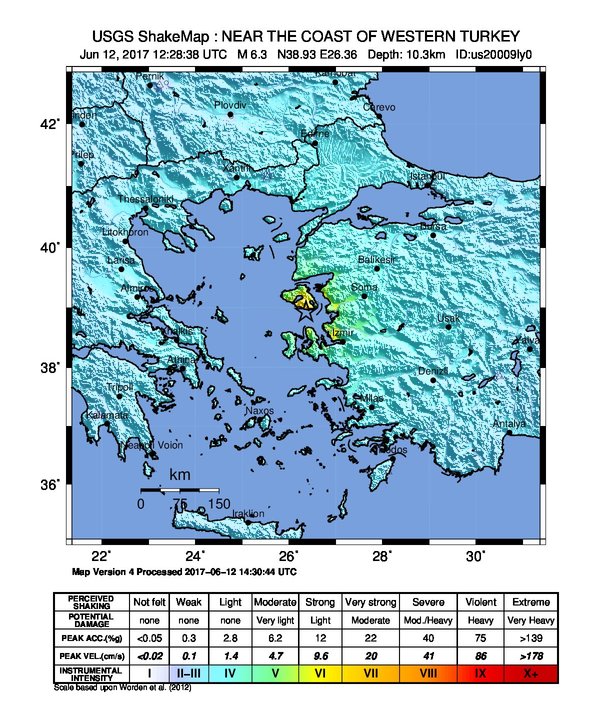M6.3 Plomarion, Greece, Earthquake
Status: Closed
| Type of posting | Posting date(EST): | Summary | Downloads |
|---|---|---|---|
| First Posting | 6/12/2017 11:45:00 AM |
|
First Posting | Summary
Posting Date: June 12, 2017, 11:45:00 AM
An M6.3 earthquake struck 4 km south of Plomarion, on the Greek Island of Lesbos (Lesvos), in the Aegean Sea on June 12, 2017, at 12:28 UTC, impacting the islands of Lesbos and Chios; shaking was also felt in some coastal provinces of Turkey. The United States Geological Survey (USGS) recorded the depth at 10.4 km, and officials recorded at least 20 aftershocks.

ShakeMap of the earthquake that struck 4 km south of Plomarion, Greece, on June 12, 2017. (Source: USGS)
The Mediterranean is a seismically active region, and Turkey and Greece sit on significant fault lines. Turkey’s western Aegean coast has already experienced several temblors of up to M5.5 this year, and small earthquakes are an almost daily occurrence in both countries. The June 12 earthquake occurred in the Aegean Sea in the western part of the Anatolia microplate. The westward movement of this relatively rigid plate in response to the collision of the Arabian and Eurasia plates in the east and the subducting Mediterranean oceanic crust under the Hellenic arc in eastern Greece is responsible for much of the frequent seismic activity in Turkey and Greece.
These complex geodynamics have contributed to widespread extension and active faulting in western Turkey and the Aegean Sea. Many recent earthquakes in Greece and western Turkey, including the 1999 Athens earthquake that caused more than 140 deaths and billions in losses, is due to this tectonic extension process. Today’s earthquake is also a normal faulting event, which is consistent with the regional tectonics.
Reported Damage
Regional fire service supervisor Marios Apostolides told Greece's ERT state TV that dozens of homes have collapsed and roads are blocked in the village of Virsa on the Greek island of Lesbos; a landslide and fallen rocks have reportedly blocked off its main road. The Mayor of Plomarion, Manolis Armenakas, told ERT that old and new buildings sustained some damage, which is still being evaluated. Shaking on Lesbos and Chios, which was felt inland in Athens, sent hundreds people from buildings into the streets. Minor injuries were reported.
In Turkey, tremors were also felt in densely populated Istanbul and in the western Turkish provinces of Izmir; there were no immediate reports of damage in these locations.
Exposure at Risk
The epicenter of this earthquake was offshore from locations with lower population densities when compared to larger inland cities in the region. However, structures in this region are generally vulnerable to earthquake shaking; buildings of reinforced concrete and reinforced/confined masonry construction are the most common in the area, and are typically low- or mid-rise. Some recent earthquakes have resulted in secondary hazards, such as landslides, which can contribute to losses.